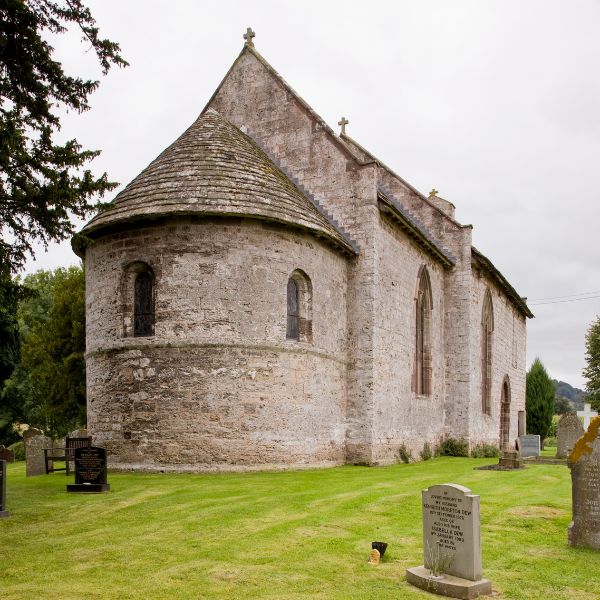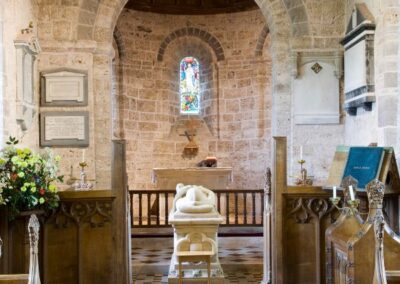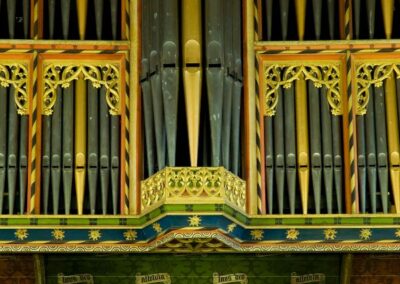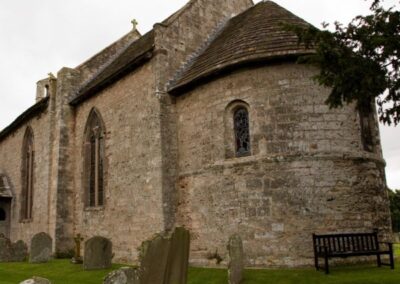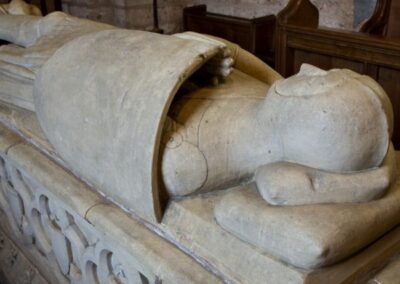St Michael & All Angels is a Norman church built of tufa in 1130 AD (by the same masons who built Kilpeck church). The church, on the site of the former Moccas Abbey, founded by the regional saint Dubricius or Dyfrig, who was born in Madley around 580 AD. The church is Grade 1 listed, and has been in continuous use since it was built.
The church is made distinctive by a rounded apse which is rare in England, but frequently seen on the continent. The building also consists of a nave and chancel, with a small bell turret at the western end. The font, the north and south doorways and the north and west windows are Norman. The other windows are from the 14th century are in the Decorated style.
In the chancel is the tomb -chest of a 14th century knight. The knight is bearing his shield but his hands are folded in prayer and his legs are crossed, resting on a lion. He is believed to belong to the de Fresne family (possibly Sir John or Sir Reginal de Fresne) who held the manor from the 13th century.
The four major windows of the church located in the nave and chancel date from the early 14th century, and are important surviving examples of the work of an English studio of the period 1130-50. The same studio was responsible for the Great East Window at Gloucester, the Tewkesbury Abbey choir windows and the Jesse tree windows at Ludlow, Tewkesbury and Bristol, as well as the local churches of Madley and Eaton Bishop.
The church was restored by Sir George Cornewall in collaboration with Gilbert Scott Junior in the 1870s. The organ was built by R W Walker and Sons and placed in the organ loft above the vestry. The case was decorated by Charles Eamer Kempe (1837-1907), and is a wonderful unparalleled composition. Indeed it is showcased in the 2021 Choir and Organ Calender , which selects 12 organs from across the world .
Our church is far more than just a historic building and well known landmark in the village. It’s a place where we gather with our families and friends to share in key life events, as well as for regular Sunday worship, Easter, Harvest and Christmas; and where we put on special musical events and talks for the surrounding community.
The church is in a remarkable parkland setting, with uninterrupted views to the surrounding hills and the Wye Valley; is close to important Neolithic sites on Dorstone Hill, and is within two miles of two important National Nature Reserves, one of which (FLITS) has public access, as well as other beautiful places to walk such as Moccas Hill Wood, Merbach Common and the Wye valley walk. Our beautiful church and churchyard are open to visitors every day, and of course it’s always a joy to see the building full of life and activity.
Location
Moccas
Hereford
HR2 9LH

